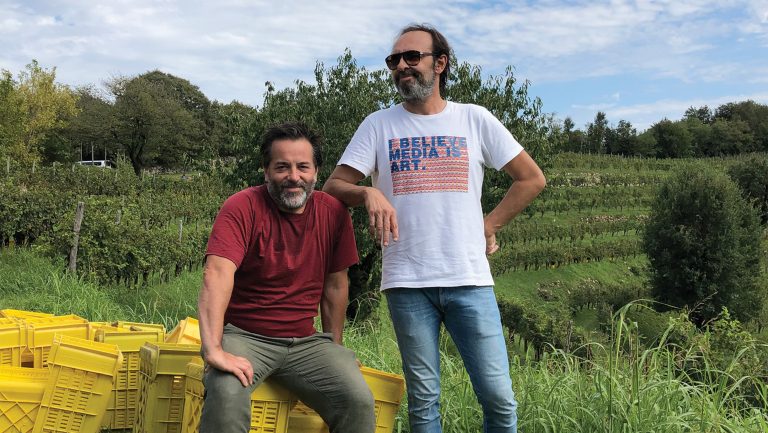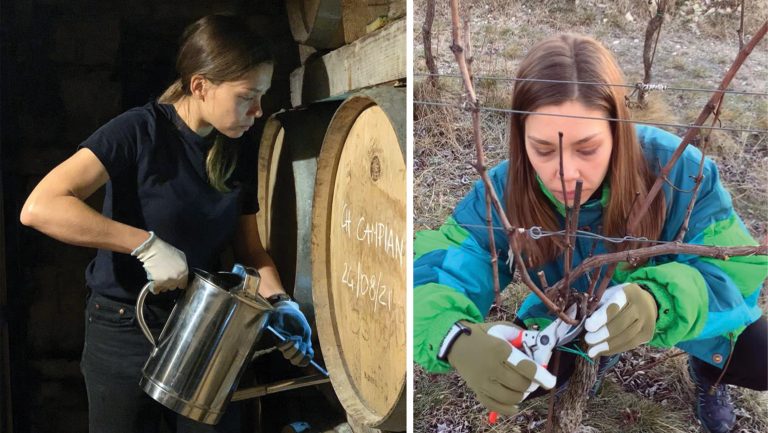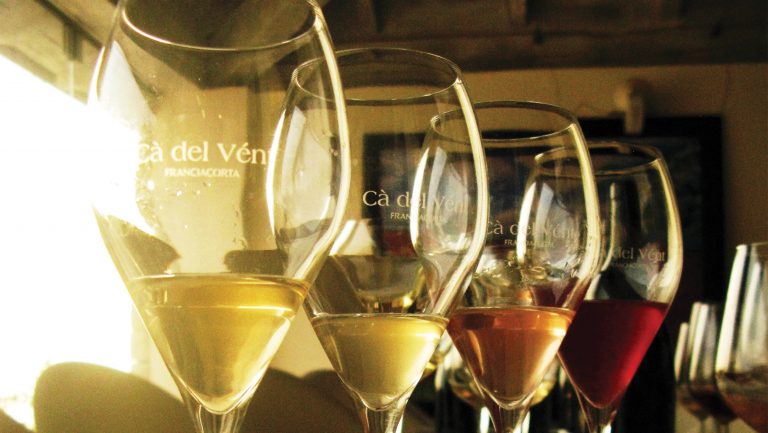To understand the identity crisis that has long plagued the wine producers in Franciacorta, we may as well start with the puzzle of its name. According to one of several conflicting accounts, it was none other than Charlemagne who, upon settling in the region in the year 774 and, finding it reminded him of home, affectionately dubbed the area “Little France.”
Whether fact or fiction, the story speaks to the very real challenge the region has faced in establishing its own unique place in the world of sparkling wine. Ever since the 1960s and ’70s, when a well-financed cadre of winemaking estates set up shop in this hilly patch of Lombardy with the goal of transforming it into a powerhouse of premium sparkling wine, Franciacorta’s identity has revolved around a single imperative: to imitate Champagne.
Not content merely to adopt the classic Champenoise grapes of Chardonnay and Pinot Noir (Pinot Blanc is allowed as well) and its signature méthode Champenoise of secondary fermentation in bottle, the region also lifted Champagne’s famous “Grand Marque” model, whereby several large Franciacorta houses historically purchased and blended grapes from across the region to maintain a consistent house style.

Don’t miss the latest drinks industry news and insights. Sign up for our award-winning newsletters and get insider intel, resources, and trends delivered to your inbox every week.
Half a century later, this strategy has catapulted Franciacorta to fame within Italy, securing its status as the tipple of choice of Milan’s fashionable elite. But as critics have often pointed out, the category has struggled to gain a foothold in the U.S. After all, with prices for Franciacorta rivaling those for Champagne, why splurge for the knockoff when you could just buy the real thing?
Thus, we arrive at the crossroads Franciacorta faces today. Fortunately, a small but growing cohort of winemakers—some working within the Franciacorta denomination, others choosing to opt out of the DOCG—have made it their mission to carve out an alternative path. As they collectively cast aside Champagne’s exaggerated influence, they’re asking a simple yet revolutionary question: What would it mean to reimagine Franciacorta not as a ready-made style inspired by somewhere else, but as a singular expression of place?
As this evolution continues to unfold, the contours of an alternative Franciacorta paradigm are now coming into view. And at a time when authenticity has become the most valuable form of currency among the next generation of wine drinkers, the groundbreaking bottles that have emerged from this shift have recently started to claim their rightful place on progressive wine lists and retail shelves across the U.S.

Rethinking Metodo Classico for a Warmer Region
No one has fought harder to deconstruct the Franciacorta establishment’s outdated logic than Giovanni Arcari, a Lombardy native who, along with his partner Nico Danesi, founded the visionary Arcari + Danesi project in 2006. Their goal? To finally wean the region off its codependent relationship with Champagne. After all, that original analogy never quite added up, and the reasons why are twofold: geography and climate.
Think about it: In the chilly vineyards of Champagne, grapes wage an epic battle to achieve ripeness. It follows that the set of winemaking practices that form the méthode Champenoise developed in direct response to that struggle, using techniques such as refermentation in bottle, chaptalization, and added sweetener (dosage) to transform acidic, underripe grapes into something delicious. By contrast, located nearly 1,200 kilometers southeast of Champagne’s capital of Reims and moderated by the warming influence of Lake Iseo, Franciacorta’s Brescia province offers growers optimal conditions for evenly and consistently ripening their grapes.
To Arcari and others like him, Franciacorta’s woes derive from a fundamental failure to account for that difference. “We here in Italy are still stuck trying to copy [Champagne’s] methodology, both in the vineyard and the cellar, without looking at the overarching idea of how this technology or winemaking approach fits with our climate, the grapes we grow, or the identity of our territory,” he explains. “I fail to see how a wine made using a method that was developed more than a thousand kilometers away could ever be successful for expressing the identity of our land.”
It’s hard to argue with this diagnosis. But rather than blame the method itself, Arcari believes the deeper fault lies in the formulaic “copy-and-paste” way it has long been applied in Franciacorta. In this way, he’s one of several winemakers—including rising stars such as Antonio Tornincasa of the Cà del Vént project in the remote hills of Cellatica, the Gussago zone’s Alessandra Divella and Nicola Gatta, and the Corte Fusia project in the area of Monte Orfano—who are actively fine-tuning the metodo classico to better reflect the particularities of their own home turf.
“It’s not always easy to introduce people to these wines. But once they taste them, they immediately understand that these are among the greatest sparkling wines in the world.” – Laura Bartram, E&R Wine Shop
Unsurprisingly, much of this progress has come through trial and error. “Over time, we decided to get rid of many things that were considered the dogma of the classic method, but which we felt were unnecessary to make great wine here,” explains Tornincasa, who has earned a reputation as one of the area’s most restlessly non-programmatic winemakers. His bracing, high-altitude wines from the remote hills of Cellatica were rejected by Valore Italia, which evaluates all potential Franciacorta wines for DOCG inclusion, as “atypical” (he currently uses the generic VSQ, or “Quality Spumante Wine” designation). “From this point of view, the idea of our wine is to offer something transparent and not driven by style.”
Even among the progenitors of this new paradigm, there’s no consensus for exactly how to enact that mandate. But in what might seem like a twist of irony, the course they are pursuing generally follows a minimalist playbook that will be familiar to anyone versed in the grower rebellion that recently upended the balance of power in Champagne.
For one, that signals return to more virtuous (read: organic or biodynamic) farming, using ambient yeasts for the primary fermentation, and investigating alternative ways to kickstart the secondary fermentation. Some, like Arcari + Danesi, have even replaced the cane sugar historically used in the liqueur de tirage with grape must of the same vintage. Most critically of all, rather than picking early to keep Champagne-like acidity levels, they focus upon harvesting physiologically ripe grapes that eliminate any need for dosage—hence the latest wave of zero-dosage bottlings that emphasize the nuances of grape and soil.
The goal, however, isn’t imitation. To a self-taught winemaker like Divella, it’s all part of the larger mission of figuring out what “here” is supposed to taste like. “We have a very recent history,” she observes. “Viticulture goes back here for centuries, but we’ve only been making sparkling wine since the 1960s. We need time to understand what we have and how to express it.”

A Complicated Question of Regional Identity
Perhaps the most exciting aspect of this experimentation is the counterpoint it provides to the conventional notion of Franciacorta as a homogenous wine. Shaped by five different periods of glacial activity, the Franciacorta zone consists of an incredibly complex tapestry of soil types, microclimates, elevations, and terroirs. To its credit, the Franciacorta consortium has made conscious efforts to highlight this diversity, including an elaborate zoning study first launched in 1992. But as Italian wine expert Ian d’Agata explains in Italy’s Native Wine Grape Terroirs, “identifying a terroir effect in Franciacorta’s wine can be difficult in most cases because the majority of estates blend together grapes from many different communes.”
The small-scale producers driving change in the region today are challenging that notion both in theory and in practice. Their efforts to excavate the identities of their respective subzones provide a fresh opportunity to pick apart distinctions between Franciacorta’s various communes—even if current DOCG regulations preclude them from printing such place names on the label.
It’s largely this restriction that prompted Alessandra Divella, along with fellow defectors Nicola Gatta and Antonio Tornincasa, to declare her independence from the Franciacorta denomination altogether. Instead, she bottles her vivid lineup of zero-dosage bottlings under the village name of Gussago. A lesser-known subzone in Franciacorta’s cooler, higher-altitude eastern sector, not far from the rugged Campi di Cellatica where Cà del Vént is perched, the area has lately emerged as a creative laboratory for Franciacorta’s new guard.

“It’s very important to me that my wines show their connection to the land where I work,” Divella says. “Unlike the better-known parts of the region, Gussago is a pre-Alpine area, with a higher elevation and a very particular set of Jurassic limestone soils that give the minerality, structure, and acidity I look for.” That tension is tangible in her racy Blanc de Blancs, for instance, fermented in equal parts concrete tank and used barrique and aged 30 months on the lees, as well as her Ni Nì bottling, a savory blend of Pinot Noir and Chardonnay that walks a tightrope between ripe orchard fruit and a faintly oxidative edge (a result of the reserve wine that constitutes 25 percent of the blend).
“We here in Italy are still stuck trying to copy [Champagne’s] methodology … without looking at the overarching idea of how this technology or winemaking approach fits with our climate, the grapes we grow, or the identity of our territory.” – Giovanni Arcari, Arcari + Danesi
Similarly, on the steep slopes of Monte Orfano, Franciacorta’s southernmost subzone, Daniele Gentile and Gigi Nembrin of Corte Fusia are crafting terroir-driven Francicaorta wines from four small parcels that had largely been abandoned during the shift to commercial production. “For us, it’s very important to emphasize that we don’t want to make the greatest Franciacorta—we want to make a great Franciacorta from Monte Orfano,” Gentile says, contrasting the “power and salinity” that characterize the zone from the “softer, more floral quality” of the wines that “come from closer to the lake.”
Next year, the project plans to release the first of a series of site-specific bottlings they started producing in 2014, which will highlight three separate vineyards planted at different elevations on the hill of Monte Orfano. There’s just one caveat: “The wines will need to have imaginary names because we’re not allowed to use the name, or cru, like they do in Barolo,” Gentile says. “This type of work is still very avant-garde here in Franciacorta.”
Finding an Audience
If this next generation of metodo classico producers has ushered in a new era for Franciacorta, the good news for wine drinkers on this side of the Atlantic is that industry professionals have started to notice.
At E&R Wine Shop in Portland, Laura Bartram and Ed Paladino—two of the category’s earliest champions—have assembled one of America’s most comprehensive selections of Franciacorta’s new wave. “It’s not always easy to introduce people to these wines,” Bartram admits. “But once they taste them, they immediately understand that these are among the greatest sparkling wines in the world.”
Having struggled to find metodo classico wines that fit the parameters of the natural-leaning, Italian-centric wine list at Manhattan’s Altro Paradiso, sommelier Amanda Smeltz (the restaurant’s former wine director) recalls her first encounter with Alessandra Divella’s examples in 2019, which quickly became staples of the beverage program there. “When I first tried them, they were immediately palpable as extremely high-quality, bone-dry, super elegant sparkling wines that offered such clear expressions of their grape varieties,” she says. “If I had been blind tasting them, I wouldn’t have guessed Champagne, but I also wouldn’t have guessed Franciacorta because they’re so different from so much of the Franciacorta to which I had been exposed.”
If there was once a time when Franciacorta popped up almost exclusively in Italian restaurants, that’s also changing. At San Francisco’s three-star Michelin restaurant Quince, for instance, Nicola Gatta’s 60 Lune rosé—refined for a remarkable 60 months on the lees—currently graces the pages of the wine program alongside many of the hottest names in Champagne. It’s yet another testament to the category’s expanding relevance. But if the message is that these Italian examples have the capacity to keep company with highly coveted grower Champagnes such as Selosse or Prévost, that’s ultimately a reflection of the fact that they’re just as unique.
“These days, the public wants to drink something for what it is, not because it’s an alternative version of something else,” Quince general manager and sommelier Matt Cirne explains. “These producers are trying to make wines that actually reflect the identity of Franciacorta. That’s why I’m able to represent them on the list.”

Dispatch
Sign up for our award-winning newsletter
Don’t miss the latest drinks industry news and insights—delivered to your inbox every week.
Zachary Sussman is a Brooklyn-based wine writer whose work has appeared in Saveur, Wine & Spirits, The World of Fine Wine, Food & Wine, and The Wall Street Journal Magazine, among many others. A regular contributor to Punch, he was formerly selected as the Champagne Louis Roederer Emerging Wine Writer of the Year. He is the author of The Essential Wine Book (2020) and Sparkling Wine for Modern Times (November, 2021) from Ten Speed Press.






